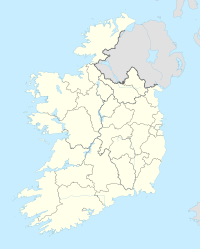Treaty ports
Location of the Treaty Ports in Ireland |
After the independence of the Irish Free State in 1922 so-called remaining three. Treaty Ports ( Treaty ports ), deep-water ports on Irish ground under the control of the United Kingdom . These were Berehaven (in the southwest of Ireland), Queenstown (later name Cobh ) and Lough Swilly . This fact was part of the Anglo-Irish Treaty of December 6, 1921, which officially ended the Irish War of Independence .
The existence of these two ports and the inlet of Lough Swilly under British control was one of the reasons that led to the outbreak of the Irish Civil War , in which opponents and supporters of the treaty fought against each other.
The Treaty Ports remained under British control until 1938 when they were returned to Ireland under the Anglo-Irish Free Trade Agreement .
The regaining of control of these ports was an important point that made Ireland neutral in the coming Second World War .
Some people in Great Britain, including Winston Churchill , described the return as a short-sighted decision, since when the Atlantic Battle started in 1939 the ports of Berehaven and Queenstown 200 km further towards the Atlantic could have been important bases (especially for refueling ). But the then British Prime Minister Arthur Neville Chamberlain was not prepared to start another source of conflict with Ireland in view of the danger posed by the Nazi regime in Germany. The establishment of bases on Iceland (after the occupation in 1940) also alleviated this British problem.
